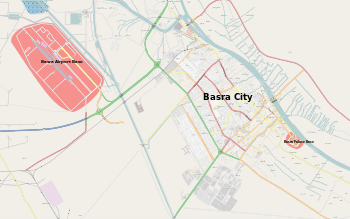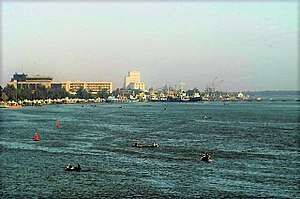Siege of UK bases in Basra
| Siege of UK bases in Basra | |||||||
|---|---|---|---|---|---|---|---|
| Part of the Post-invasion Iraq | |||||||
 Map of UK bases in Basra. Airport on the left. Basra Palace on the right. | |||||||
| |||||||
| Belligerents | |||||||
|
|
| ||||||
| Commanders and leaders | |||||||
| Wissam Abu Qader † | |||||||
| Strength | |||||||
| 6,200 | unknown | ||||||
| Casualties and losses | |||||||
|
32 killed (UK) 1 killed (DK)[2] | unknown | ||||||
The Siege of UK bases in Basra was conducted and maintained by the Mahdi Army in Basra for most of 2007. Following the reported success of the coalition Operation Sinbad, whose purpose was to stabilise Basra and prepare it for the turning over of security to Iraqi government forces, the city was overrun by insurgent forces from three different militia forces, including the Mahdi Army, and the British found themselves under siege in their bases and capable of conducting only limited raids in armoured convoys into the city.
The Bases
By this point in the war there were only two British bases left in Basra. One was on the outskirts of the city at the Basra Airport with a garrison of 5,000 personnel from all three Services, although mostly Army and RAF personnel. The second, which faced much of the fighting, was in the city center at Basra Palace, a former palace of Saddam Hussein, with a garrison of 700 soldiers.[3]
The Siege

The first British soldier to die in the city, following operation Sinbad, was killed on 27 February while returning to the Shatt-Al-Arab Hotel.[4]
The airport base was constantly hit, upwards of dozens of times a day, by mortar and rocket fire during the siege. Despite the weight of fire, there was relatively little disruption to operations, as considerable effort had been put into Force Protection measures. These included passive measures on the base, such as physical hardening of structures, and active measures, such as fighting patrols conducted by RAF Regiment squadrons in the Base's ground defense area, beyond the perimeter.
The Uti Triangle, a flat zone combining open wasteland, marsh and clustered buildings, was being used by the Mahdi army to conduct the mortar and rocket attacks on both the airport and the palace.[3][5] Aggressive patrolling activity had denied the militias the opportunity to use the airport's ground defence area for launching anything other than a small number of rockets. However, this may have had the effect of forcing the militias to use firing points that were further away, which meant that larger rockets, with correspondingly larger warheads were used.
More than 300 rockets hit the airport in the two months between June and August. Sniper attacks were also a deadly and common occurrence for British Service Personnel as well as IED attacks on patrols that were going out of the bases. The IED attacks and organised ambushes also hit convoys from the airport that were transporting food, fuel, ammunition and other equipment for the palace. Convoys were primarily used for this task because helicopters were at high risk from being shot down.
Retreat from Basra Palace
On September 3, under the cover of darkness and without any media attention, the British Army retreated from Basra Palace to the airport, leaving their last foothold it had in the city. Basra was abandoned to the militias.[6]
Aftermath
Following the withdrawal the UK was heavily criticized for pulling back from the city, mostly by the U.S. military.[7] Formally, control of the city had been handed over to Iraqi security forces, but in effect the control of the city was in the hands of radical militias. They led a turf war in the coming months over control of the city and up to 100 people, mostly civilians, were being reported killed each month. A black market monopoly formed over the oil exports from the city.
At the end of March 2008, the situation in the city led to an Iraqi troop surge into the city and the 2008 Battle of Basra.
British forces remained in control of Basra Airport until 2009 when it was handed over to Iraqi civilian control. Number 7 RAF Force Protection Wing and 15 Squadron RAF Regiment were the last British forces to leave. An interesting historical coincidence saw the same units being the last British forces to leave Camp Bastion, Helmand, Afghanistan, in November 2014.
See also
References
- ↑ Cochrane Marisa "The Battle for Basra", page 4 - Institute for the Study of War
- ↑ http://icasualties.org/Iraq/Fatalities.aspx
- 1 2 Under siege - Times Online Archived January 10, 2008, at the Wayback Machine.
- ↑ "MoD names soldier killed in Iraq" BBC News 28 February 2007
- ↑ "Death in Basra: the British under siege", the Times, Times Online, August 9, 2007, archived from the original on 16 August 2007
- ↑ British withdraw from Basra - PBS Newshour
- ↑ Senior US military say British suffered "defeat" in Basra and left people of the city to be "terrorised", BBC Press Office, 29 September 2010